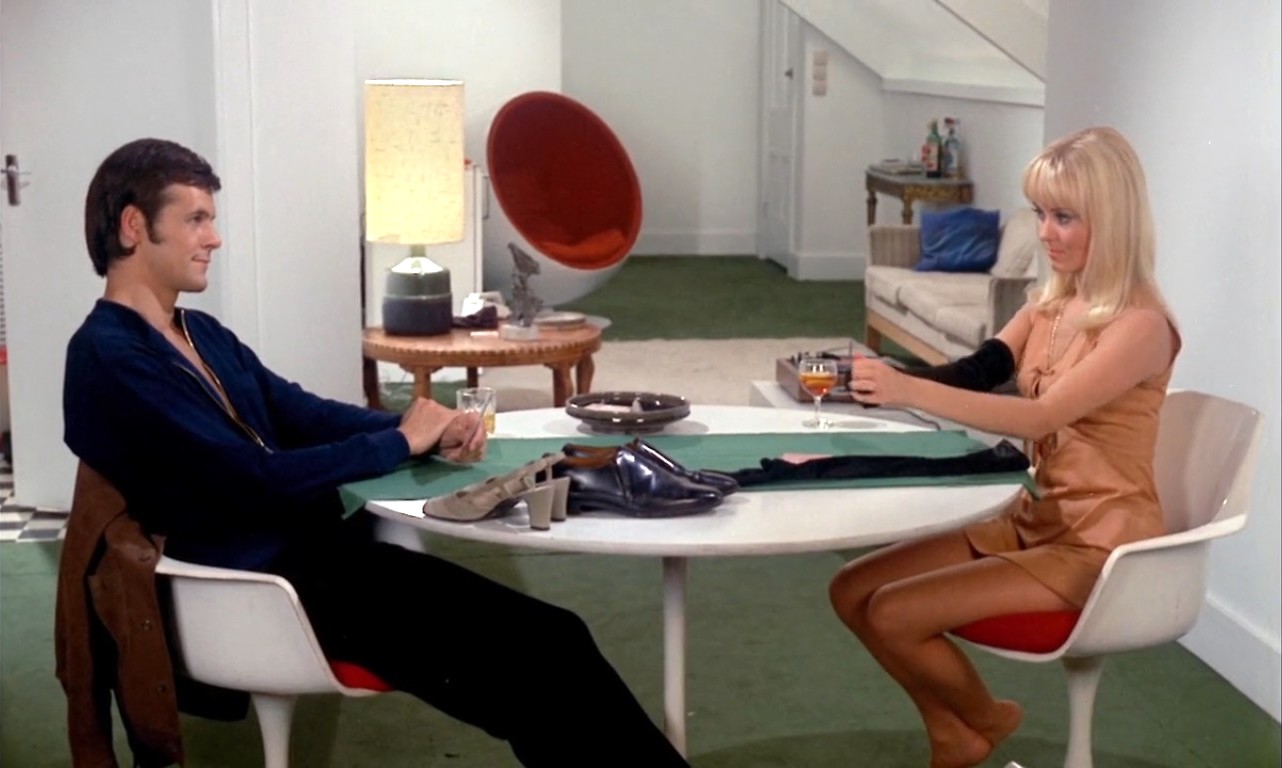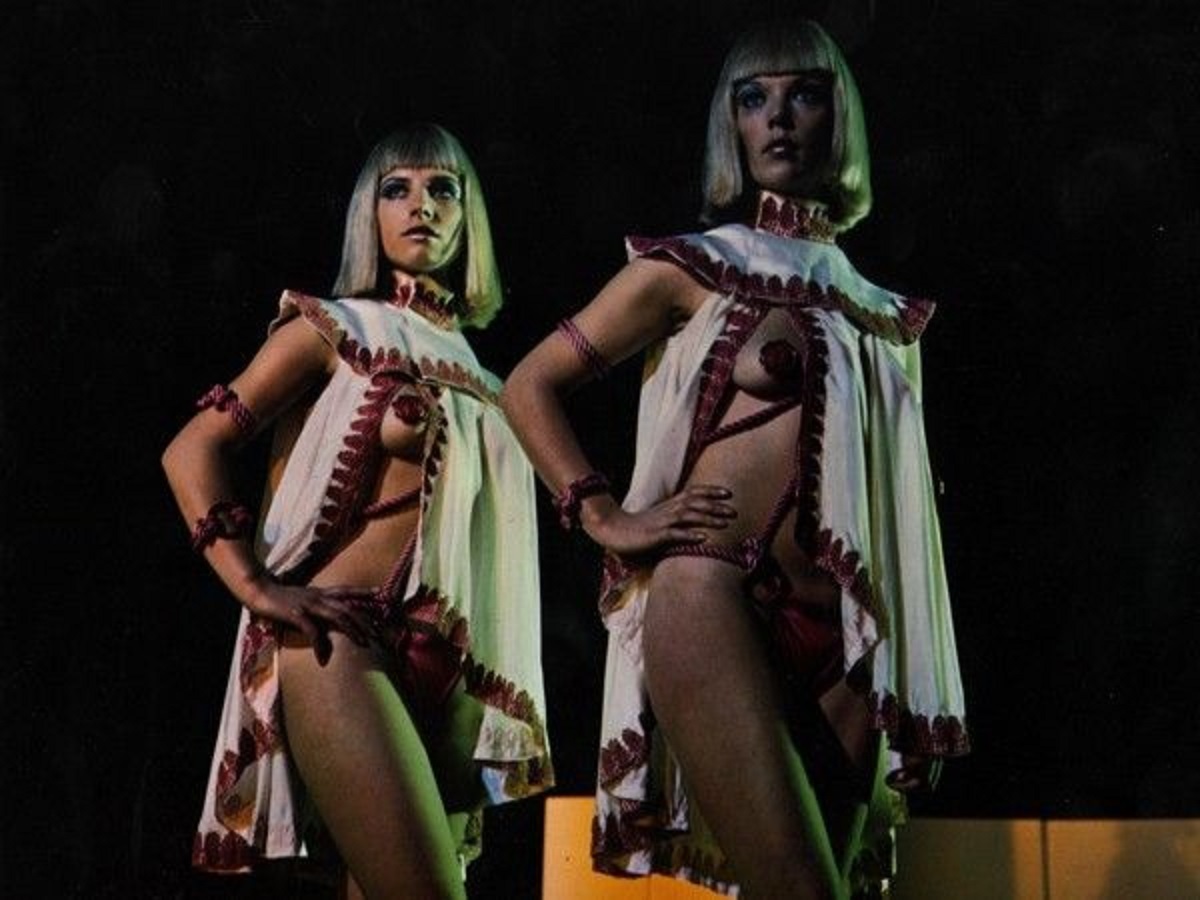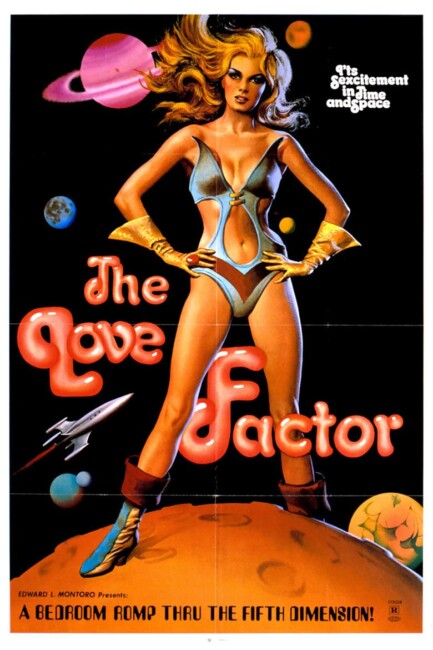aka The Love Factor
UK. 1969.
Crew
Director – Michael Cort, Screenplay – Michael Cort & Alistair McKenzie, Based on a Story from Zeta Magazine, Producer – George Maynard, Photography – Jack Atchelor, Music – Johnny Hawksworth, Art Direction – Martin Gascoigne. Production Company – Tigon British Film Productions Limited.
Cast
Robin Hawdon (James Word), James Robertson Justice (Major Bourdon), Yutte Stensgaard (Ann Olsen), Charles Hawtrey (Swyne), Wendy Lingham (Edwina ‘Ted’ Strain), Anna Gael (Clotho), Brigitte Sky (Lachesis), Dawn Addams (Zeta), Valerie Leon (Atropos), Lionel Murton (W), Carolanne Hawkins (Zara)
Plot
James Word, a spy for Section 5, returns to his apartment to find the department’s secretary Ann Olsen waiting for him. As they relax over a game of strip poker, she pushes him to relate the story of his latest assignment. He was assigned to tail Major Bourdon who had been conducting an investigation into the women from Angvia. Led by Zeta, who may be from another planet, the all-women secret society regularly abducted other women into their ranks where they were brainwashed to become operatives. Bourdon’s men became certain that the Angvians were next planning to abduct stripper Edwin ‘Ted’ Strain and set a trap for them. As Bourdon’s men took several of the Angvian agents prisoner, the stage was set for a confrontation between the various parties at Bourdon’s estate in Scotland.
Zeta One was one of the films from the UK company Tigon British. Tigon were most known as an imitator of Hammer Films, producing several entries in the Anglo-horror cycle with the likes of The Blood Beast Terror (1968), The Sorcerers (1967), Matthew Hopkins – Witchfinder General (1968), Curse of the Crimson Altar (1968), Scream and Scream Again (1970), Blood on Satan’s Claw (1971) and The Creeping Flesh (1972), among others.
Zeta One is an oddity. It feels like an awkward attempt to sling together several competing trends of the day. Mostly it is jumping aboard the massively popular fad for Spy Films that came in the wake of the success of the James Bond films. It is also a sex comedy. This period saw new censorship freedoms around the world and nudity was suddenly permissible on screens. Britain produced a number of sex romps with very softcore elements – nothing that went much beyond lots of bare boobs – and with a strong emphasis on the comedy.
In this regard, Zeta One is simply taking the James Bond spy film to a logical extreme – Bond copies like Our Man Flint (1966) and the Matt Helm films with Dean Martin starting with The Silencers (1966) took Bond’s womanising to a level of absurdity showing their heroes surrounded by hordes of stacked scantily-clad women; Zeta One simply takes it one step further and gives audiences what they want to see – the women undressed. Into the bargain, Zeta One is also attempting to be a science-fiction film jumping aboard the genre’s renewed popularity following 2001: A Space Odyssey (1968).

What Tigon have done here is turn to Zeta magazine. I am unable to glean much information about Zeta magazine. (This is not to be confused with Zeta, a Spanish-language Mexican investigative magazine that has been published since 1980). Zeta began in 1968 in broadsheet format and published at least eighteen issues, possibly more. Trying to get your mind around what Zeta was is rather puzzling. It seems to exist halfway between a nudie magazine and a science-fiction serial (the planet Angvia that the women come from is an anagram for ‘vagina’, for instance). It told an ongoing story about the battles with the alien women and featured plentiful photo-illustrated layouts with women in fashionable mini-skirts and various degrees of undress lounging amid plastic vacuform furniture intended to suggest a futurism.
On screen, this ungainly mixture of competing elements unbalances the film. The scenes with topless women are allowed to overrun everything. The opening scene involves a Miss Moneypenny figure (Yutte Stensgaard) turning up in Robin Hawdon’s apartment and seducing him to tell the story of what happened, which we then get in flashback. You could easily see this as the equivalent of the teaser that takes place in a Bond film but in this case the various games of strip poker and seduction between the two of them are allowed to drag out for twenty minutes before the main story starts.
The spy plot happens very lazily – mostly the film is there to get between one strip scene, one bedroom encounter and the next. For example, Robin Hawdon wants to interview Wendy Lingham’s stripper who is suspected of being the next abductee but rather than take her in for questioning, he merely delivers her a message to come around to his flat, only for him to return to the flat to be detained by an Angvian woman in the bedroom until nearly three-quarters of the way through the film. It seems head-scratching to have a spy film in which the actual spy figure is not present in the midst of the action for most of the show.
Eventually, when the action does take place at James Robertson Justice’s estate in Scotland, this mostly consists of an Angvian rescue party – who naturally arrive in costumes that have less material than a bikini – running around the woods zapping goons with a magic touch from their fingertips.

If Zeta One fails as a spy film, it is even less successful as science-fiction. For one, it seems to have no clear idea where the Angvian women come from or what they are. They are variously said to come from another planet or ‘another timescale’ (whatever that might mean) or possibly somewhere on Earth, while at other points it is said that all but Zeta herself are brainwashed women who have been abducted. If they are terrestrial, then how come they have scientifically advanced technology? For that matter, it is not even clear what the Angvians are trying to achieve. What seems apparent is that the film is tapping the theme in some of the late 1960s spy films – sees the likes of In Like Flint (1967), Some Girls Do (1969) and the Dr Goldfoot films – where women were conspiring against men or at the least being turned into brainwashed fembots to go and kill them.
One of the more amusing aspects is when the film tries to copy 2001 and throw in a light show to represent the brainwashing – only this is a cheaply rendered set of psychedelic lights and naturally there is a nude woman’s body floating in the midst. The most amusing scene – even if it feels out of place – is where Robin Hawdon gets into a lift at ministry headquarters only to find it is an artificially intelligent elevator with a pissy attitude – a scene that you cannot help but think inspired Douglas Adams when it came to the almost identically-voiced Marvin the Paranoid Android in The Hitch-Hiker’s Guide to the Galaxy (1981).
Among the cast are several starlets who went onto a name at Hammer Films, including Yutte Stensgaard who was Carmilla Karnstein in Lust for a Vampire (1971) and Valerie Leon who was the lead in Blood from the Mummy’s Tomb (1971), as well as Dawn Addams who played in The Vampire Lovers (1970) as Zeta herself. Robin Hawdon later went onto become a successful British novelist and playwright. He just seems too quiet a personality to do the dashing spy figure and spends most of the film behind an archly amused smile. Top-lined is burly James Robertson Justice who had a long and distinguished career on both sides of the Atlantic, although the film cannot seem to decide if he is meant to be playing a super-villain or what.
Trailer here


